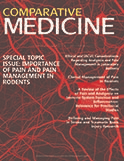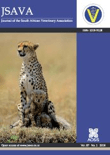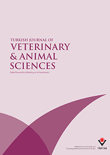
COMPARATIVE MEDICINE
Scope & Guideline
Enhancing understanding through groundbreaking laboratory research.
Introduction
Aims and Scopes
- Laboratory Animal Science:
The journal covers a wide array of topics within laboratory animal science, including housing, care, and management of various species used in research settings. - Animal Models in Biomedical Research:
A central theme is the use of animal models to study human diseases, enabling researchers to gain insights into pathophysiology, treatment, and drug development. - Veterinary and Clinical Research:
Research involving veterinary medicine and clinical practices for laboratory animals is highlighted, providing essential information on health management and disease prevention. - Ethics and Welfare in Animal Research:
The journal emphasizes the ethical considerations and welfare implications of using animals in research, advocating for humane endpoints and improved living conditions. - Innovative Research Methodologies:
There is a consistent focus on developing and validating novel research methodologies that enhance the reliability and reproducibility of experimental results.
Trending and Emerging
- Microbiome Research:
There is a growing interest in the role of the microbiome in health and disease, with studies exploring its effects on various conditions, including gastrointestinal health and immune responses. - Translational Research Approaches:
An increasing number of publications focus on translational research that bridges the gap between basic science and clinical applications, particularly in developing new therapies. - Xenotransplantation Studies:
Research exploring the use of animal organs for transplantation in humans is gaining traction, particularly with pigs as potential donors, addressing the critical shortage of human organs. - Innovations in Anesthesia and Pain Management:
Emerging methodologies in anesthesia and pain management for laboratory animals are being highlighted, reflecting a shift towards more humane and effective practices. - Genetic and Molecular Studies:
There is a rising trend in genetic and molecular research, including the use of genetically modified organisms to study disease mechanisms and therapeutic responses.
Declining or Waning
- Traditional Pharmacology Studies:
Research focused solely on pharmacology without integrating modern methodologies or cross-species comparisons has been less frequently published, indicating a shift towards more comprehensive approaches. - Basic Pathology Studies:
There is a noticeable decrease in purely descriptive pathology studies, as the field moves towards studies that incorporate mechanisms, treatment responses, and translational aspects. - Historical Animal Research Practices:
Topics related to historical practices or outdated methodologies in laboratory animal research have diminished, as the field prioritizes contemporary and innovative techniques. - Single-Species Focused Studies:
Research that examines a single species in isolation without comparative analysis has seen a decline, reflecting a trend towards studies that consider multiple species for broader insights. - Conventional Animal Housing Practices:
Papers discussing traditional animal housing without an emphasis on enrichment or welfare improvements are becoming less common, as the focus shifts to enhancing animal well-being.
Similar Journals

Journal of the South African Veterinary Association
Fostering Innovation in Veterinary MedicineJournal of the South African Veterinary Association is a prominent Open Access journal dedicated to advancing the field of veterinary science since its inception in 1945. Published by MEDPHARM PUBLICATIONS PTY LTD, this journal stands out with an impactful HIndex and a commendable categorization in 2023, ranking Q3 in Medicine (miscellaneous) and Q2 in Veterinary (miscellaneous). With a Scopus rank of 96 out of 194 in the veterinary field, it serves as an essential resource for researchers, veterinary professionals, and students, promoting the dissemination of high-quality research and knowledge. The journal offers a platform for peer-reviewed articles covering diverse topics relevant to veterinary and animal health issues, encouraging expansive dialogue and collaboration within the academic community. Based in Centurion, South Africa, and accessible globally since it adopted an Open Access model in 1997, the journal exemplifies a commitment to accessibility and the sharing of knowledge.

Ankara Universitesi Veteriner Fakultesi Dergisi
Disseminating groundbreaking insights for animal welfare.Ankara Universitesi Veteriner Fakultesi Dergisi is a prominent academic journal published by ANKARA UNIV, focusing on advancements in veterinary sciences and animal biology. Since its inception, the journal has been committed to disseminating high-quality research, featuring articles that span a variety of topics within veterinary medicine and animal science. With an ISSN of 1300-0861 and an E-ISSN of 1308-2817, this journal provides valuable insights into the latest research developments and trends, making it a critical resource for researchers, professionals, and students in the field. The journal has established itself within the scholarly community, achieving a Q3 rank in Animal Science and Zoology and a Q2 rank in Veterinary (miscellaneous) as of 2023, reflecting its growing relevance and impact. Positioned in Turkey, it serves as a vital platform for both local and international scholars to share innovative findings and foster collaboration. Enhancing its accessibility, the journal's content is available through various academic databases, ensuring that its readership can effortlessly access and engage with cutting-edge research.

Frontiers in Veterinary Science
Pioneering advancements in veterinary medicine.Frontiers in Veterinary Science is a premier open-access journal dedicated to the latest advancements and research in the field of veterinary science. Published by FRONTIERS MEDIA SA in Switzerland, the journal has been at the forefront of disseminating high-quality research since its establishment in 2014. With an impressive rank of #15 out of 194 in the general veterinary category and a high percentile of 92nd in Scopus rankings, it is recognized as a leading publication in veterinary medicine and related disciplines, maintaining a prominent Q1 quartile status as of 2023. The journal promotes the wide dissemination of knowledge through its open-access policy, ensuring that researchers, professionals, and students have unrestricted access to critical findings and innovations in veterinary science. Nestled in the vibrant academic landscape of Lausanne, Switzerland, Frontiers in Veterinary Science is not just a journal; it is a vital resource for advancing veterinary practices and improving animal health globally.

SCANDINAVIAN JOURNAL OF LABORATORY ANIMAL SCIENCE
Elevating Standards in Laboratory Animal WelfareSCANDINAVIAN JOURNAL OF LABORATORY ANIMAL SCIENCE, published by the Scandinavian Society of Laboratory Animal Science, serves as a critical resource for researchers and professionals in the fields of veterinary science, animal biology, and biochemistry. Since its inception in 1996, this journal has consistently aimed to advance the understanding and welfare of laboratory animals through rigorous scientific research and innovative methodologies. Although it currently holds a Q4 ranking in several categories, including Animal Science and Zoology, it remains an essential platform for disseminating findings that influence both ethical practices and scientific advancements. The journal has converged its publishing years from 1996 to 2012 and 2014 to 2024, reflecting its commitment to ongoing research discourse. While it does not offer open access, the content within promises to deliver invaluable insights to enhance the quality of laboratory practices. Situated in Denmark, the journal invites contributions that foster a better understanding of the complexities of laboratory animal science, ensuring relevance and significant impact within the global scientific community.

Animal Reproduction
Exploring the forefront of veterinary and husbandry practices.Animal Reproduction is a premier open-access journal published by the Brazilian Coll Animal Reproduction, focusing on the dynamic field of reproductive biology within both veterinary science and animal husbandry. Established in 2004, the journal has rapidly gained prominence, securing a Q2 ranking in both Animal Science and Zoology as well as veterinary disciplines as of 2023. With a growing impact factor and an engaged readership, Animal Reproduction serves as a vital platform for researchers, professionals, and students seeking to disseminate and gain insights into the latest studies and innovations in animal reproductive health and technology. Based in Brazil, the journal's content spans a wide array of topics essential for advancing the scientific understanding of reproduction in animals, thus contributing to improved practices in veterinary medicine and livestock management. The journal is indexed in major databases such as Scopus, ensuring that the research published is accessible to a global audience. Whether you're a seasoned researcher or a student looking to deepen your knowledge, Animal Reproduction is indispensable for anyone engaged in this critical area of study.

TURKISH JOURNAL OF VETERINARY & ANIMAL SCIENCES
Fostering Knowledge for Veterinary Excellence.TURKISH JOURNAL OF VETERINARY & ANIMAL SCIENCES is a distinguished peer-reviewed journal dedicated to advancing knowledge in the field of veterinary sciences and animal health. Published by the Tubitak Scientific & Technological Research Council Turkey, this journal provides a platform for high-quality research, fostering scientific inquiry that spans various aspects of veterinary medicine, animal biology, and animal husbandry. With an impact factor that reflects its growing influence within the Q3 category of Veterinary (miscellaneous) according to the 2023 rankings, it is strategically positioned in the academic landscape, ranked #112 out of 194 in the broader veterinary field. The journal is committed to open access publications, ensuring that research is accessible to a global audience, facilitating collaboration and knowledge sharing among researchers, professionals, and students. By covering a broad spectrum of topics from clinical research to veterinary policy, the TURKISH JOURNAL OF VETERINARY & ANIMAL SCIENCES plays a crucial role in enhancing the understanding and welfare of animal species, thereby contributing significantly to both scientific advancement and practical applications in veterinary practice.

Animal Models and Experimental Medicine
Fostering collaboration for transformative experimental medicine.Animal Models and Experimental Medicine is a prestigious open-access journal published by WILEY that has been a significant contribution to the field of biomedical research since its inception in 2018. Focusing on the role of animal models in the exploration of experimental medicine, the journal has garnered attention for its rigorous peer-reviewed articles that bridge laboratory research with clinical applications. The journal currently holds impressive quartile rankings, including Q1 in Medical Laboratory Technology, Veterinary (miscellaneous), and strong standings across various other categories, reflecting its reputable position within the Scopus rankings. With a commitment to disseminating high-quality research that advances knowledge and practice in veterinary and medical sciences, Animal Models and Experimental Medicine offers a platform for researchers, professionals, and students to contribute to and stay informed about pivotal developments in the field. As an open-access journal, it ensures accessibility, encouraging a wider readership and fostering collaboration among the scientific community.

Open Veterinary Journal
Fostering Innovation in Veterinary Medicine, One Article at a TimeOpen Veterinary Journal, published by the University of Tripoli, Faculty of Veterinary Medicine, offers a vital platform for the dissemination of research in the field of veterinary sciences. With an ISSN of 2226-4485 and an E-ISSN of 2218-6050, this journal has been committed to open access since 2011, allowing for unfettered access to its content, which ensures that researchers, practitioners, and students worldwide can benefit from the latest veterinary research findings. Operating from Libya, it has garnered an important position within the academic community, achieving a Q2 quartile ranking in the scope of veterinary (miscellaneous) and maintaining a Scopus rank of 104 out of 194 within the general veterinary category, indicating its growing influence and reach. The journal focuses on a diverse array of topics pertinent to contemporary veterinary practice, aiming to bridge gaps in knowledge and foster collaboration among scholars and practitioners. As it continues to publish original research and reviews, Open Veterinary Journal stands as a crucial resource for advancing veterinary medicine, supporting innovative research, and enhancing educational outcomes within the profession.

Iranian Journal of Veterinary Research
Elevating Animal Health Through Innovative ResearchWelcome to the Iranian Journal of Veterinary Research (IJVR), a prestigious platform dedicated to advancing the field of veterinary science. Published by Shiraz University, this journal plays a pivotal role in disseminating high-quality research findings amid a vibrant academic community. With its ISSN 1728-1997, and a convergence of studies from 2008 to 2024, IJVR serves as an essential resource for veterinarians, researchers, and students interested in Animal Science and Zoology. Recognized in the Q3 quartile for both Animal Science and Veterinary categories, it holds a respectable position with Scopus rankings placing it in the 54th percentile among general veterinary journals. Although it currently lacks an open access model, the journal ensures that cutting-edge veterinary research is presented with rigor and relevance, fostering knowledge that contributes to animal health and welfare. With its strategic focus on innovative methodologies, clinical practices, and the biological sciences, the IJVR is set to become your go-to source for critical advancements in veterinary research.

ACTA VETERINARIA BRNO
Enriching Veterinary Science with Cutting-Edge ResearchACTA VETERINARIA BRNO is a distinguished journal published by the Veterinární a farmaceutická univerzita Brno in the Czech Republic, focusing on innovative and scholarly research in the field of veterinary sciences. With an established history dating back to 1974, this journal has evolved to maintain its relevance in contemporary veterinary research, as evidenced by its inclusion in Scopus and a respectable Q3 rank in the miscellaneous veterinary category. Despite operating under traditional access models, ACTA VETERINARIA BRNO remains a vital resource for researchers and practitioners seeking to advance their understanding of veterinary medicine and related disciplines. With its commitment to publishing high-quality, peer-reviewed articles, the journal serves as a crucial platform for disseminating significant findings, thereby contributing to the enhancement of animal health and welfare globally.